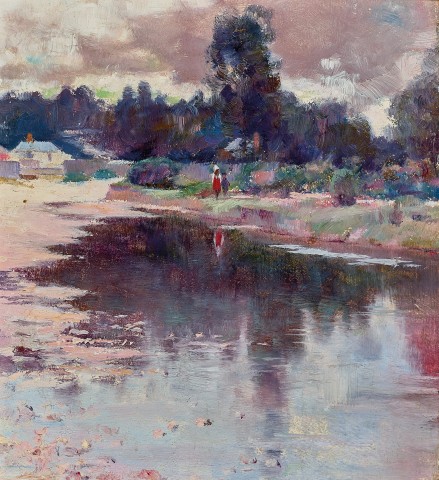ELTHAM, c.1898
WALTER WITHERS
oil on wood panel
22.0 x 20.5 cm
bears framer’s label verso: Robt R. Stanesby, Yarra Street, Geelong
Estate of Mrs I. Higgins, Geelong (pupil of Walter Withers)
Thence by descent
Private collection, Melbourne
Deutscher~Menzies, Melbourne, 26 November 2003, lot 128
Savill Galleries, Melbourne (label attached verso)
Deutscher and Hackett, Melbourne, 9 May 2007, lot 54
Private collection, Sydney
In the face of parental opposition to his desired career as an artist, Walter Withers came to Australia from England in 1883, working initially as a jackaroo before settling in Melbourne where he enrolled at the National Gallery School. Continuing art studies begun earlier at London’s Royal Academy and South Kensington Schools, there he met fellow students Louis Abrahams and Frederick McCubbin, as well as the older Tom Roberts – all of whom became lifelong friends – earning him the nickname ‘The Orderly Colonel’ as a result of his efficient manner and efforts to organise his colleagues.1 After a brief sojourn abroad studying at the Académie Julian in Paris alongside Australian expatriates E. Phillips Fox, Tudor St George Tucker and John Longstaff, Withers subsequently returned to Australia in 1889, soon moving to Heidelberg outside Melbourne, where he rented Charterisville, ‘a fine old stone mansion with a large barn and stables… a wild romantic garden… a broken fountain, and an odd pedestal here and there [which] suggested the glory of other days.’2 When the lease was taken over in 1894 by Phillips Fox and Tucker, who ran a school there offering instruction in plein air painting, the location became a popular gathering place for local artists.
Renowned as an artist ‘who went out [in]to nature and made sincere and successful attempts to represent her varying moods’3, Withers’ art was widely acclaimed during this final decade of the nineteenth century when Eltham, c.1898 was most likely painted. In 1894, the National Gallery of Victoria had purchased A Bright Winter’s Morning, 1894 for its permanent collection and Tranquil Winter, 1895 was acquired the following year.4 The Storm, 1896 (Art Gallery of New South Wales) was awarded the inaugural Wynne Prize for landscape painting in 1897 – for which he received a generous payment of £40 – and in 1900 Withers won the prestigious prize again. A measure of international acknowledgement came too, with the inclusion of Tranquil Winter in the colonial art exhibition in London in 1898.
Many of Withers’ subjects were areas close to his home – especially around Heidelberg and later, Eltham – locations he could walk or cycle to, which he reportedly often did with a prepared canvas and lightweight, portable easel slung over his shoulder.5 Heidelberg was like a small, rural village when Withers lived there during the 1890s, providing many picturesque views which he recorded in oil paint and watercolour. This changed as the city and suburbs grew and in 1903, with funds earned from a major commission to paint a series of narrative panels for the majestic home of pastoralist W. T. Manifold at Camperdown in western Victoria, Withers and his family moved to Eltham. Located about twenty kilometres north-east of Melbourne, Eltham offered a country environment and experience, with access to the city via a recently established railway service. As Fanny Withers wrote, ‘Purchasing a cottage there, with an orchard attached, he built for himself a charming Studio, the windows of which open on to a bit of Virgin Bush, where stand stately white gums of great beauty’.6 Having worked in and around Eltham previously, it was an area Withers knew well, and the decision to live there permanently proved to be productive for his art, offering limitless sources of inspiration, as the present work attests. ‘Every form of subject was there before him, with the added charm of rural figures at work in the paddocks, as tending their animals near the homesteads, as following the cows towards the milking sheds; in riding their horses to the creek for water. All these incidents were noted by the painter.’7
1. For Withers’ full biography, see Clark, J., and Whitelaw, B., Golden Summers: Heidelberg and Beyond, National Gallery of Victoria, Melbourne, 1985, pp. 28 – 29 and Andrew Mackenzie, ‘Withers, Walter Herbert (1854-1914)’, Australian Dictionary of Biography, National Centre of Biography, Australian National University at https://adb.anu.edu/biography/withers-walter-herbert-9156/text16183
2. Whitelaw, B., ‘Melbourne’s Answer in the 90s – ‘Charterisville’’ in Clark & Whitelaw, op. cit., p. 172
3. ‘Art of Walter Withers’, The Argus, Melbourne, 29 July 1919, p. 6
4. A Bright Winter’s Morning, 1894 was purchased in 1894 and then exchanged with the artist for Tranquil Winter, 1895 the following year. A Bright Winter’s Morning was reacquired for the NGV collection in 1956 when it was bequeathed by Mrs Nina Sheppard.
5. Mackenzie, A., Walter Withers: The Forgotten Manuscripts, Mannagum Press, Lilydale, 1987, pp. 24, 30
6. Ibid, p. 27
7. Ibid. p. 130
KIRSTY GRANT
